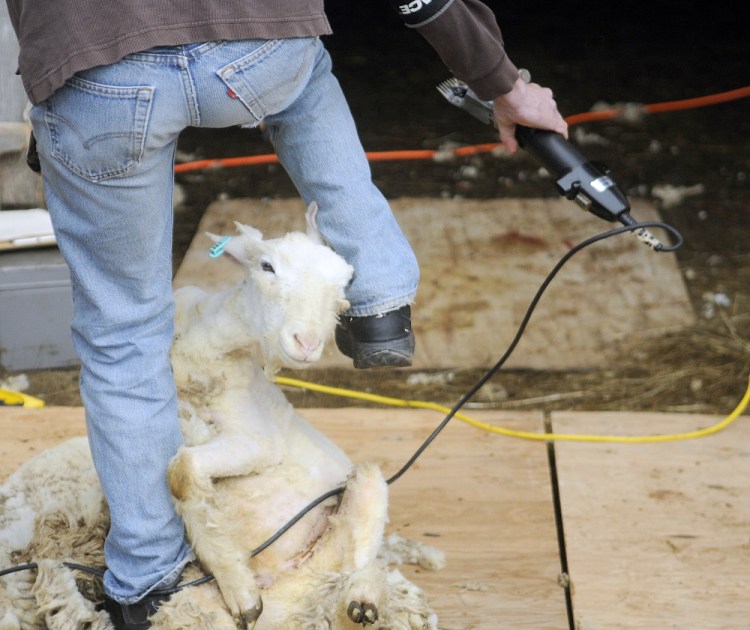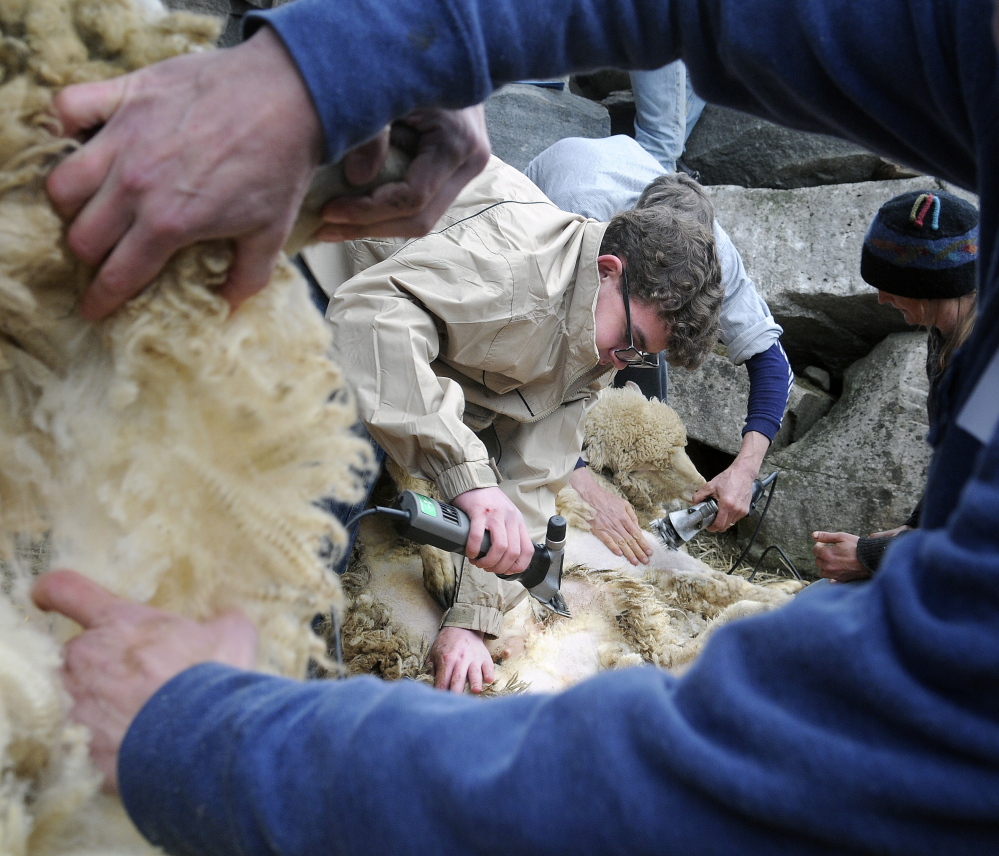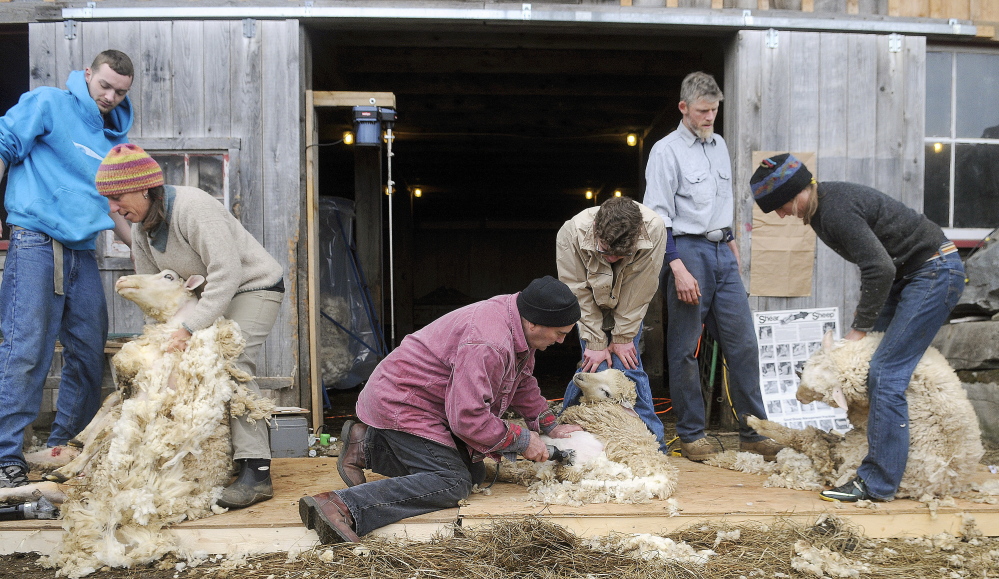WASHINGTON — “We’re going to do a lot of shearing, so keep going,” said Richard Brzozowski, agriculturist and small ruminant and poultry specialist with the University of Maine Cooperative Extension service.
He was talking Sunday to the six people enrolled in the day-long intermediate sheep-shearing course sponsored by the extension service and the Maine Sheep Breeders Association.
The lessons took place on a small platform outside the barn at Nanne Kennedy’s Seacolors Yarnery at Meadowcroft Farm on Hopkins Road.
Kennedy had offered her flock of more than 100 sheep as subjects so the shearers could improve on their techniques.
“This is my annual harvest,” she said, as she anxiously checked the shearers’ progress while also handling the wool, grading, sorting, skirting, bagging and tagging it assisted by Carlo Montagano. “It will all go into different piles,” she said.
Kennedy raises fine wool sheep, a breed known as Polwarth, which she had worked with in New Zealand and recreated in the United States around 1990.
The advantage to the breed is that the wool doesn’t itch, Kennedy said, holding up a swatch of newly shorn wool that felt smooth and soft.
In the background, Gwen Hinman, of Acworth, N.H., who’s been a professional sheep-shearer for about 15 years, gave instructions to a student holding a buzzing electric razor in one hand as he cradled a sheep between his legs. “You’re going to go perpendicular to her backbone,” Hinman told him.
He asked about holding out one of the legs to trim it.
“You’re not supposed to,” Hinman said with a smile.
She offered advice to another shearer on handling the razor: “We’re not jamming it in. We’re just sort of rolling with it.”
Emily Garnett, of Jefferson, helped another student as she awaited her turn to shear. Already experienced with shearing her sheep and those of her neighbors, she too wanted to improve her technique.
“Handling the sheep is 90 percent of it,” she said. “If you can hold them in the right position so they’re comfortable, it makes it easier on everybody.”
But getting the hold right was proving difficult.
A few sheep were brought out of the barn literally dragging their hooves. Few wanted to be placed onto their rump and held upright for the New Zealand-style shearing in store.
Further out in the pasture, some of the newly shorn sheep pulled at piles of hay, baaing loudly at each other, seemingly protesting their spring frocks.
Joe Woodbury Jr., 15, of Salisbury, Mass., had taken the beginner class last year and was back for additional instruction.
“I shear our sheep and want to start a business shearing sheep in our area to put aside money for college so I can become a mechanical engineer,” Woodbury said. He expects to make good money because there’s not a shearer within 50 miles and some 25 sheep farms within that area.
He hoped to improve his shearing and sheep-handling skills, at one point asking his father to grab a toothbrush from the van so he could clean off the blades on the handheld electric razor.
Joe Woodbury Sr. had driven the family to Camden on Saturday and his son to the class that began early Sunday while the temperature was still pretty chilly.
“We have found from experience and reviews that this is the best place to get the training,” Woodbury Sr. said. He added that he expected his son and the other students would be exhausted at the end of the day.
“It’s bending over the whole time,” he said, watching his son handle a particularly feisty sheep.
The bend was particularly tough on 6-foot-5-inch Alex Meissner, who works on a farm in Dover, N.H., that has 115-120 sheep.
“I’m here to hone my sheep-shearing skills to do it more efficiently where I work,” he said. “We don’t have an annual shearing day. We do it when we need to.”
Meissner said he has some trouble shearing lambs. “I’m hoping to improve my ability to keep them in position. Because I’m so tall their legs slip out from between mine.”
Carl Schwink, of Durham, admired the professional shearers’ technique. “The ones who make a living have to do two minutes or less per sheep,” he said.
He wanted to gain more experience. “I’m learning how to handle the sheep better so it can go smoother and faster, so it’s better for me and better for the sheep,” Schwink said. He sells his wool to hand-spinners.
It wasn’t clear whether all Kennedy’s sheep would be shorn by the students on Sunday, but there were no worries.
Kennedy said that in previous years, she and Hinman and a wool handler could have the flock done by tea time.
Along with their experience, the students would be taking home a manual, a “How to Shear Sheep” poster and a DVD.
“They keep learning after this,” Brzozowski said.
Betty Adams — 621-5631
Twitter: @betadams
Send questions/comments to the editors.






Success. Please wait for the page to reload. If the page does not reload within 5 seconds, please refresh the page.
Enter your email and password to access comments.
Hi, to comment on stories you must . This profile is in addition to your subscription and website login.
Already have a commenting profile? .
Invalid username/password.
Please check your email to confirm and complete your registration.
Only subscribers are eligible to post comments. Please subscribe or login first for digital access. Here’s why.
Use the form below to reset your password. When you've submitted your account email, we will send an email with a reset code.